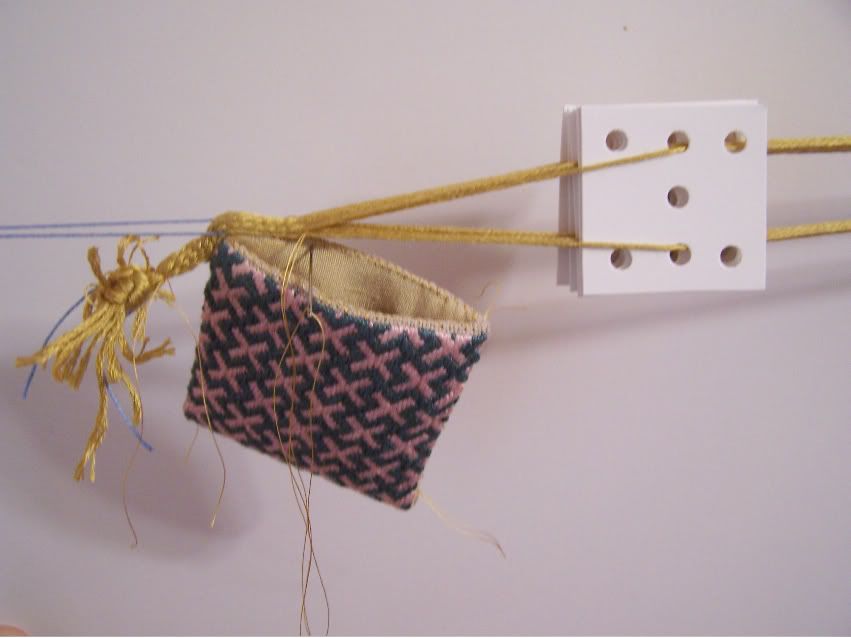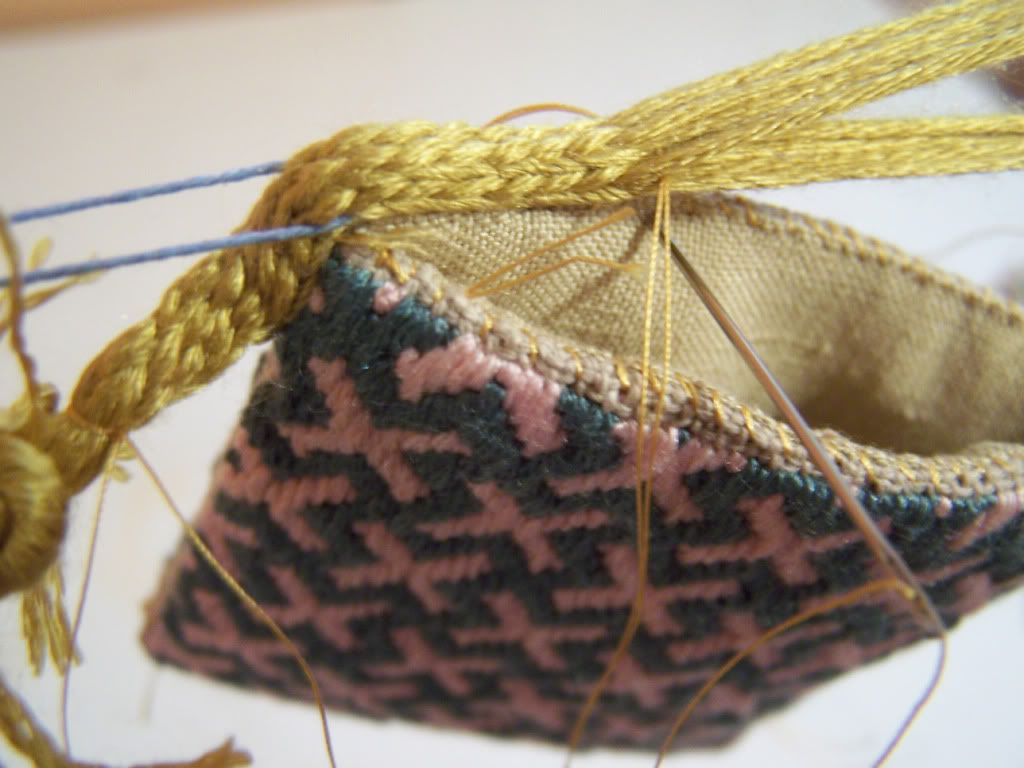As for the direction of the side-stitching: I don't know if anyone's researched this in depth or not. I've gotten into the habit of starting on the top corner, moving across the top edge, and down the side. This way, when I finish I can use the leftover 'warp' for a corner tassel. I can't tell you if this is an historically accurate way of doing it or not; I have neither seen nor done the research myself at this point. As always, comments and criticisms are always welcome :-)
The main problem I've found with the above method is due to the fact that it takes two people to work: one manipulating the loops, one stitching, and both trying to maintain a consistent tension. At the moment, I don't have anyone around to be that second person. So, I've been experimenting with a one-person method; replace the finger loop idea with a series of tablets, with only two threads per tablet, and alternating between Z and S orientation. Move the pack of tablets forward a half-turn for each pick.
With a bit of practice, and some luck, I managed to make it work!


See that blue thread holding on to the purse on the left? When the time comes to turn the corner and work down the side, I'll put another loop through the fabric under the corner, and then attach that to the anchor at the left. This way, you're always working in a straight line, which is obviously what the threads want to do anyway. Obeying the laws of physics is key to not going insane during a project like this..




6 comments:
I have seen photos of several bags that look as if they have tablet woven edges. I tried this for my gold basket weave pattern bag and I really liked the result. I used the weft thread to stitch into each side of the bag as I wove so both sides were sewn to the weaving as I went. It worked out nicely. Here is the post on another blog that made me think of doing it that way:
http://maxlu179.livejournal.com/8947.html
I used more tablets, with four threads per tablet, and once I reached the top corner of the bag I kept weaving and made the strap continuos with the side finishing. Then when the strap was long enough I started on the other side of the bag, once again using the weft to stitch up the side seam. I used the leftover thread on both ends (which was located in the bottom corners of the bag) to make tassels. This whole process ate up a LOT of silk and if the silk hadn't been a gift I'm not sure I would have been bold enough to try that.
Here is my post that shows the results:
http://medievalartcraft.blogspot.com/2008/08/as-promised-better-pictures-of.html
P.S. I like what you did with just the two threads. It finishes it nicely and uses a lot less thread.
I was able to achieve the original technique you mentioned by myself but it was such a huge pain that I was emotionally scarred by the experience and will likely never do it again!
Tablet weaving with alot of tablets and very fine silk for the edges can be seen on Museum of London bags. (but I don't know of any which carry on for straps). As Kathy says, start at the bottom corner and go around - the excess either side forming the tassels. However, at the top, you split the pack in half - creating an opening and enclosing the top seams at the same time. When you get to the other side you join up again, and go down the side.
Using the extra thread to maintain tension on the loom is how I do it as well.
The loop only method may be causing you some difficulty because you are using too many loops. On the purses I have seen which use this method, you only need two loops (usually of a different colour). You can then put the purse between your legs and it's alot easier to manage two loops and sew through at the same time, much like embroidery.
On this page you'll find purses which use both (TW at the top) though the pic of the loop only isn't as close-up - http://www.et-tu.com/ginb/ginagallery/bags/drawstring-bags.asp and tw here - http://www.et-tu.com/ginb/ginagallery/bags/diptych-bag.asp
Thank you, both! Very helpful :-)
I also found a translation of the mentioned posting at the Medieval Silkwork blog: http://m-silkwork.blogspot.com/2007/04/finishing-seams-of-14th15th-century_29.html
Thanks for pointing me to this postings - I think I'll try it... :)
replica bags korea check it out g0k62r6w63 replica bags karachi see this website m3j25w8q32 gucci replica replica bags from china hermesreplica bags neverfull replica hermes bags k2q48c9x34 7a replica bags wholesale
Post a Comment